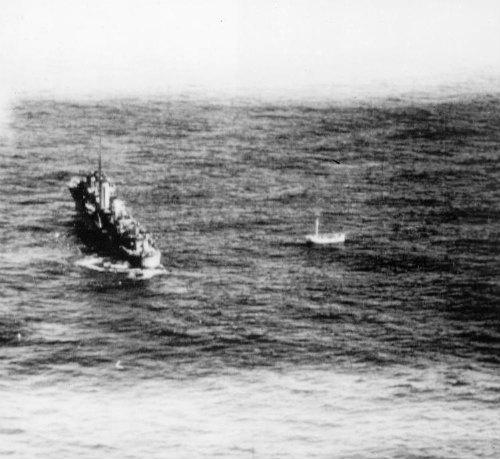‘Back from the dead!’ The amazing survival story of Lifeboat 12

The sinking of the City of Benares is a story with few bright spots. Horrific loss of life, particularly amongst children, makes for grim research. There are stories from the tragedy that show the full strength of human endurance, two teenage girls clinging on to an upturned lifeboat for 18 hours through the night in freezing waters and managing to survive, a 7 year old boy who survived the night on a raft amongst sleet and hail and choppy seas. One story of endurance however was only realised 8 days after the sinking, when a further 45 survivors were discovered. Newspaper headlines described them as, ‘back from the dead’.
Lifeboat 12 was one of the only City of Benares lifeboats not to become waterlogged after launching and, though this helped protect its occupants from the exposure that claimed so many lives, it meant that it drifted far further than any of the others. By the time help arrived the lifeboat’s course had led it outside the search pattern of the rescuing destroyer. Given the awful weather conditions, it was believed that Lifeboat 12 simply hadn’t lasted the night and its occupants were listed amongst the dead. Though this was by no means the case, the 46 people aboard the lifeboat were in an unenviable position. Thirty-seven crewmen, six evacuee children with two of their adult escorts, and one private passenger, were sharing an open boat about 8m long. They were in the middle of the Atlantic, roughly 600 miles from land and, though fairly well provisioned with food, there was only 16 gallons of fresh water on board.
Upon seeing no sign of rescue, the ship’s officers realised they had no choice but to head for land, a journey for which an optimistic estimate was 8 days. Water was rationed at two servings of roughly 85ml per person per day. (To put this in context an average sized soft drink can holds 330ml.) If they couldn’t find land on the 8th day the water supply would be gone. Conditions were cramped and desperately uncomfortable. Many of the people on board were not properly dressed, including the six young boys, and the weather was often poor. Some of the boys and one of their escorts, Father Rory O’Sullivan, had no shoes and suffered badly with painful, swollen feet as a result of the cold and wet conditions. The adults on board all did what they could to try and help the boys and afterwards Father Rory wrote to the mother of Douglas Critchley, a Sea Cadet and fellow Lifeboat 12 survivor, full of praise for her son. The letter is now held in the Archives Centre at the Maritime Museum.
“when some of our children began to suffer from their feet, he showed us how to chafe them and I can remember how he held one boy in his arms, the boys feet being tucked into his shirt”
Reverend Joseph Chorpenning from St Joseph’s University in Philadelphia, a friend of Father Rory’s from later in life, was kind enough to send me a copy of his wartime memoirs which made for fascinating reading. I was particularly struck by the calm and matter of fact style in which he recounted his wartime experiences. He recalls how at one point after he had fainted:
“When I came to, I found I was wrapped in a blanket and I could hear people saying I was not going to last much longer.”
But last he did. On 26 September 1940, with their situation grim and water nearly gone, the occupants of Lifeboat 12 spotted a Sunderland Flying Boat. It was flying low, on the look out for U-boats, and spotted Lifeboat 12. Signalling that they were going to get help, the plane left and returned a few hours later with the destroyer HMS Anthony. Of the 46 people in the lifeboat, 45 survived to be rescued (one seaman, unbalanced from the circumstances and drinking saltwater, had jumped overboard and drifted away). Another crewman died shortly after rescue but, thanks to the diligent care from their escorts and the other adults, the six boys all recovered from their experience and incredibly four of them went on to join the Navy later in life. Father Rory had the pleasure of surviving to read his own obituary, remarking:
“If only one took the trouble to tell people while they were alive of all the good things one thought about them!”
The recovery of Lifeboat 12 restored many loved ones to grieving families but further horror awaited the lifeboat’s occupants when they learnt what had become of the rest of those on board. Two of the rescued boys found that their brothers had died in the sinking and the two escorts, Father Rory and music teacher Mary Cornish, learnt with horror of the loss of so many of their charges and colleagues. Still, to a shocked nation, this story of survival was a minor miracle, the restoration of loved ones given up for lost, a small bright spot in a dreadful tragedy. One of the six boys to survive in Lifeboat 12 was Billy Short, one of eleven Sunderland children on board the City of Benares from which only two survived. On 3 October 2015 there was a memorial service to mark the 75th anniversary of the disaster, organized by the Sunderland Volunteer Life Brigade, at 11am in All Saints Church, Fulwell Road, Sunderland. The Brigade also put together a small exhibition to mark the anniversary, see here for details.
Lead image: HMS Anthony rescuing survivors from lifeboat 12 © IWM (CH 1354)
